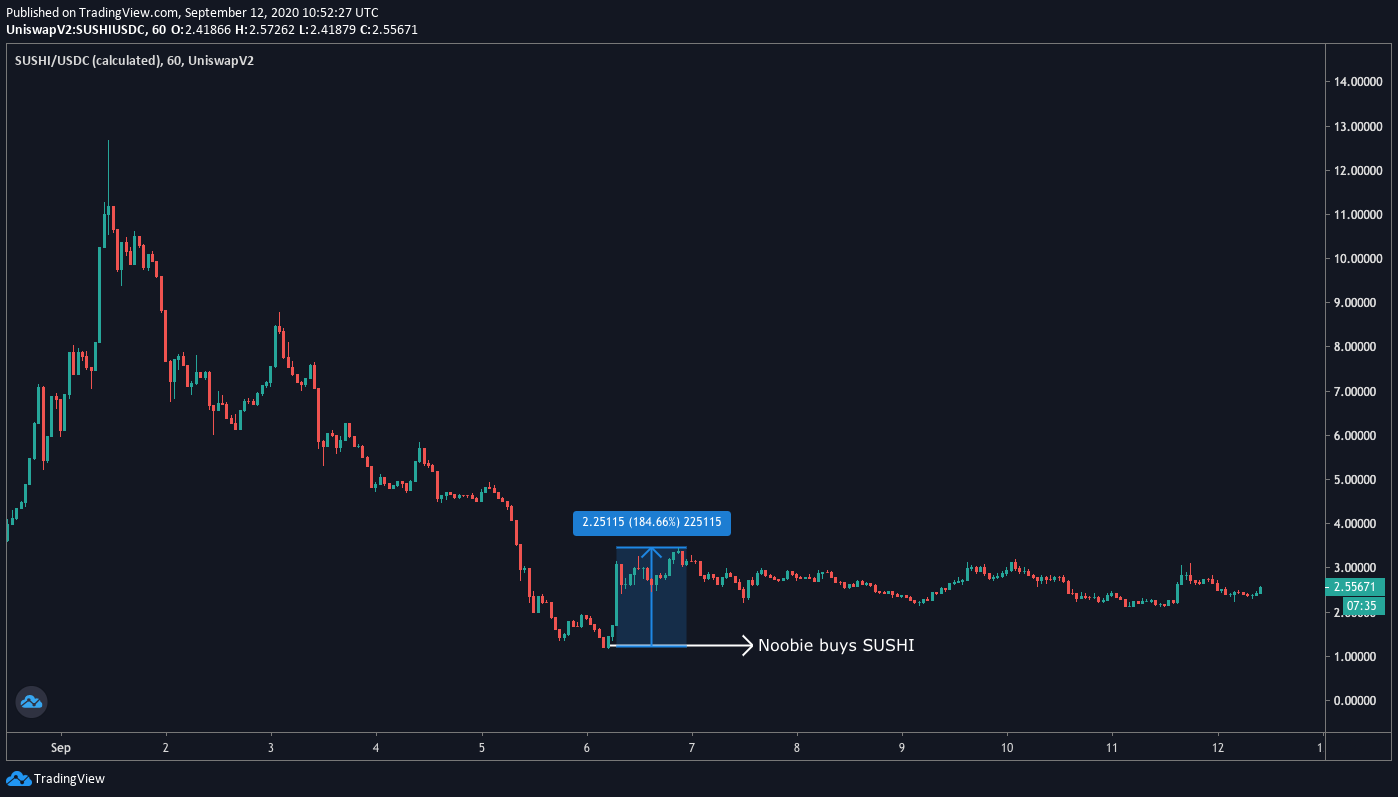Key Takeaways
- Public blockchains aim to incorporate a mix of transparency and privacy, though efforts to implement the latter are still a long way off.
- A lack of on-chain privacy measures threatens the informational moat of DeFi’s biggest whales.
- Tracking whales and mimicking their intricate trading strategies can be a source of alpha for savvy traders.
- But this advantage will not last forever, as privacy on Ethereum is imminent.
Share this article
DeFi whales use their millions of dollars to amass more millions and move markets. Smaller traders with less capital and more patience can copy this success by tracking their every move and mimicking their strategies.
Piggybacking off the fortune of insiders and whales has never been this easy.
Public Blockchains, Privacy, and DeFi
Radical transparency is a hallmark of blockchain technology. Any time money moves, whether a million dollars or a penny, it’s publicly recorded and accessible to anyone.
The ability to publicly audit transactions and the state of an accounting ledger is integral to decentralized networks. But this is far from ideal for privacy-centric users.
Thus, ensuring a healthy balance between privacy and transparency has always been the goal of many crypto communities. Yet, leading networks like Bitcoin and Ethereum still lack meaningful privacy measures.
Despite this lack, however, very few users have made privacy a high priority for the industry. It’s still important, and resources are being allocated to build privacy-preserving tools.
But in the current bullish climate, privacy is more of a preference rather than a necessity.
Ethereum’s lack of privacy has more serious implications than most other public blockchains. This is due to the elaborate financial activity happening on the network.
Unlike Bitcoin, Ethereum’s usage isn’t restricted to a single base layer coin moving from address to address. There are thousands of applications and millions of tokens built on top of Ethereum.
With the rise of DeFi, there are tons of opportunities for users to take part in this burgeoning financial network and make money. But they must remain aware that their every move can be traced with pinpoint accuracy.
This point is even more important for large whales. These entities must be cautious to hide their motives, or they run the risk of giving up their advantage to watchful eyes.
Protecting Alpha in the Age of Financial Surveillance
In the stock market, investors have to sift through a virtual stack of regulatory filings to find insider buying and selling information. Often, this information is hardly actionable, as insiders disclose their buying and selling well after doing so.
On Ethereum, however, investors can track whale wallets and quite literally follow their every action. For example, a smaller trader who tracks whales sees one particular address buying large amounts of a few tokens during a correction.
The obvious idea is to try and front-run them. But this isn’t easy and requires technical expertise.
Instead, the easier (and riskier) option is to follow the whale into that token as they don’t usually fly blind. Indeed, their activity can even turn a correction into a very profitable trade.
Now thanks to yield farming, the practice of tracking and tracing specific addresses has undue alpha. Plus, finding the different yield farms that more prominent names are jumping in and out gives that farm an air of reliability.
Tools like Nansen and HAL are invaluable for tracking address movements.
Nansen has wallet labels that help users digest information. For example, users are labeled based on their decentralized exchange (DEX) usage, the size they trade with, and any known public labels (from ENS or otherwise).
For those that don’t want to purchase these services but are willing to put in the effort, EtherScan is another helpful tool to circle in on whales.
Exploring two examples of how to track large whales should make this much clearer.
Alameda Research is one of crypto’s largest market makers. They play with millions – if not billions – of dollars and have become one of the most active DeFi whales. If one can find a new farm that Alameda deposits a few million dollars into, they can reliably take advantage of this opportunity for at least a few days.
Though the DeFi space is full of risk, companies deploying billions of dollars have more resources and know-how than the average day trader to perform due diligence. If a new farm receives the Alameda stamp of approval, it’s likely more reliable than many others.
When everyone was busy deciding whether SushiSwap was a scam or not, for instance, Alameda deposited a few million dollars into the contract. Taking this as a sign to enter, farmers would have made a killing with just a small chunk of capital.
Drawing from the Sushi example again, one can use whale behavior as a proxy for fishing for tops and bottoms. It’s e that huge market buy orders will push prices higher. This increase in price creates more demand from speculators.
SUSHI was in freefall after Chef Nomi’s exit dump. The community was in shambles, and all hope seemed to have been lost. Then a lone whale entered to catch the plummeting token.
“Noobie.eth“ is an on-chain legend, known only by their ENS name, and is often responsible for creating the tops and bottoms seen on price charts.
At around 5:40 AM UTC on Sept. 6, Noobie pulled the trigger and bought a million dollars of SUSHI. This buy order marked the bottom for SUSHI, and the token rallied almost 200% over the next 15 hours.

In the equity market, this is the equivalent of knowing which stock Warren Buffett is buying and when he’s buying it.
DeFi Whales Aren’t Idiots, Tread Carefully
It should go without saying that the larger traders aren’t oblivious to people tracking them and attempting to copy their strategies. As such, the typical eight-figure trader has their funds segregated between 10 to 50 Ethereum addresses.
Yup, waiting for privacy solutions to not have to do this anymore.
— キノ丂ズム刀イ乇丂 (@Fiskantes) August 31, 2020
This means that users who are tracking them can only mimic a few of their strategies. People watching one address will do one thing, those watching a different address will do another. Larger traders do this so that the various opportunities at hand don’t become saturated.
Gas costs are, however, starting to prohibit the use of multiple different addresses. But, why would a million dollar trader care about $60 transaction fees?
With on-chain investigation tools, people can start to narrow down on a single whale’s various addresses. Adding gas woes to the mix, the whales themselves may resort to sending funds from one address to another, giving away their on-chain identity.
Additionally, “psyops“ have become inherent to DeFi culture. One should not be surprised to find themselves on the wrong side of a fakeout. If a whale realizes their strategies are being flooded with copycats, they will do anything to shake these traders out.
Exploit the Advantage While It Lasts
Ethereum won’t be devoid of privacy forever. Solutions like Aztec are working on thorough on-chain privacy measures. Layer two solutions like zkSync are building a trustless scaling solution for Ethereum with default privacy enabled.
The ability to track and mimic whales in DeFi is not an opportunity that will exist for the long-term. It may disappear as soon as a layer two solutions are production-ready. This is because layer two solutions can bundle multiple transactions into a single mainnet Ethereum transaction.
It’s not normal to be able to copy the most successful investors in an environment. Traders looking to exploit this edge should move fast so they can wring this opportunity for all its worth.
Because soon, it won’t be possible.
Share this article
1Inch.Exchange Announces Yield Farming Opportunity for Its Upcoming To…
Just one week after the launch of Mooniswap and bagging $2.8 million from the biggest names in crypto investing, 1inch.exchange is taking their business a step further. 1inch yesterday has…
Aztec Protocol Doesn’t Want DeFi Without Privacy, and Neither Should…
Today, Aztec Protocol, a highly-anticipated privacy layer, launched its mainnet on Ethereum. The protocol obfuscates inputs and outputs using zero-knowledge proofs, and several DeFi projects have already shown interest in…
DeFi Project Spotlight: yEarn.Finance, the Ultimate Yield Farming Mach…
yEarn Finance has quickly become one of the most popular DeFi protocols in 2020. It brings together many of the disparate tools, platforms, strategies, and tokens from throughout the ecosystem….
July BTC Market Analysis
After roughly 2 months of price consolidation following its rapid recovery from Black Thursday (March 12th), Bitcoin broke out of its range following an extended period of muted volatility. Currently…


